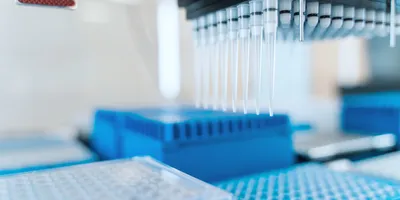
Manual liquid handling is an essential task in many laboratories, but it also comes with significant health and safety risks for laboratory personnel. Whether preparing samples for analysis or conducting high-throughput assays, repetitive pipetting exposes staff to repetitive strain injuries (RSIs), and handling biological samples can increase the risk of exposure to bloodborne pathogens and other hazardous materials. By incorporating automated liquid handling systems, labs can improve not only efficiency and accuracy but also enhance overall safety and employee well-being.
Repetitive Strain Injuries from Manual Pipetting
Pipetting is a fundamental laboratory task, often requiring repetitive and precise movements over long periods. According to research, the more frequent and repetitive the task, the higher the likelihood of developing upper limb disorders, including tendonitis, carpal tunnel syndrome, and shoulder strain. Laboratory workers who spend hours manually pipetting are at particularly high risk.
Strategies to Reduce RSI Risk
To minimize repetitive strain injuries, labs should:
- Encourage frequent breaks to allow muscles and tendons to rest.
- Rotate tasks among team members to reduce repetitive motion exposure.
- Ensure that ergonomic pipettes are available when manual pipetting is unavoidable.
- Promote proper posture and neutral wrist positions during pipetting sessions.
While these measures can help reduce risk, automated liquid handlers provide a more comprehensive and long-term solution to addressing ergonomic challenges.
Reducing Biohazard Exposure with Automated Liquid Handling
In laboratories working with biological samples, such as blood, tissue, or other bodily fluids, manual pipetting exposes staff to bloodborne pathogens and other hazardous materials. Accidental spills, splashes, and needlestick injuries are all potential risks when handling infectious samples manually.
Benefits of Automated Systems
Automated liquid handling systems minimize direct human contact with hazardous samples, greatly reducing the likelihood of accidental exposure. These systems are designed to:
- Handle samples within enclosed environments, limiting the potential for aerosol generation.
- Standardize sample transfer procedures, minimizing human error and contamination risk.
- Safely manage high-throughput workflows, allowing technicians to supervise the process without direct contact.
Improving Efficiency and Accuracy
In addition to enhancing safety, automated liquid handling systems improve overall workflow efficiency and data accuracy. These systems:
- Perform liquid transfers with high precision and reproducibility.
- Process large sample volumes faster than manual methods.
- Minimize pipetting errors caused by fatigue or inconsistent technique.
With reduced variability and improved accuracy, automated systems contribute to better experimental outcomes and more reliable data.
Customization for Different Lab Needs
Modern automated liquid handling platforms come in a range of configurations to fit laboratories of all sizes and specialties. From small benchtop units for low-volume applications to high-throughput robotic workstations capable of processing thousands of samples, there are systems available to meet the specific safety and efficiency needs of any lab environment.
Conclusion
Automated liquid handling systems represent a critical investment in laboratory safety, especially for labs that conduct repetitive sample preparation or handle hazardous biological materials. By reducing ergonomic strain and minimizing biohazard exposure, these systems help protect laboratory staff while improving accuracy, productivity, and workflow efficiency. As laboratory safety standards continue to evolve, automated liquid handling will play an increasingly essential role in promoting safe, efficient, and high-quality research.
Frequently Asked Questions (FAQ)
1. How do automated liquid handlers improve lab safety?
Automated liquid handlers reduce direct human contact with hazardous samples and eliminate the need for repetitive manual pipetting, reducing both biohazard exposure and the risk of repetitive strain injuries.
2. What are common injuries associated with manual pipetting?
Repetitive pipetting can lead to carpal tunnel syndrome, tendonitis, elbow strain, and shoulder injuries, particularly with prolonged or improper technique.
3. Are automated liquid-handling systems suitable for small labs?
Yes, modern systems come in a variety of sizes and configurations, including compact benchtop units ideal for smaller labs with lower sample volumes.
4. Do automated liquid handlers improve data quality?
Yes, by providing consistent sample handling, automated liquid handlers improve accuracy and reproducibility, leading to more reliable data.
This content includes text that has been generated with the assistance of AI. Lab Manager’s AI policy can be found here.












